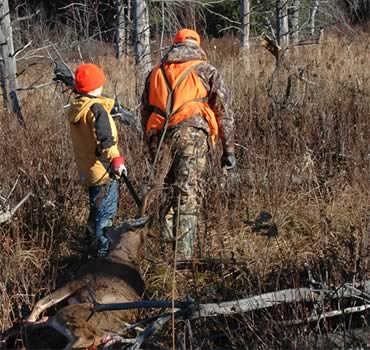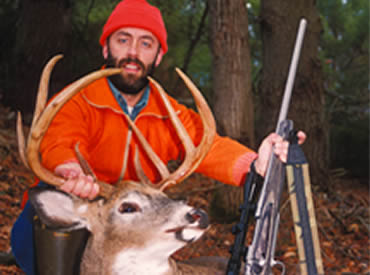Proven methods for taking deer in high-pressure locations.
I was socializing with a group of outdoor writers one day when I bumped into a comrade from a neighboring state. I opened with the appropriate greeting. “How’d your deer season go?”
Ordinarily that’s just an ice-breaker, a way to start a friendly conversation, but this time I was genuinely interested in what he had to say. It had been a particularly long and very frustrating season for me. I think part of me was hoping he’d made out similarly, and we could share the misery.
He went on about how he’d taken a big buck in Kansas, another in Illinois and a third in Kentucky. Not wanting to seem unimpressed, I congratulated him on his accomplishments before letting on that my question was directed more toward how he’d done hunting around home on his own. “Oh,” he paused for a moment, “I don’t hunt around home any more.”
He didn’t come right out and say it, but the implication was obvious. With the odds for success so much greater on a private-land guided hunt, why even bother with public land? There’s a certain amount of logic to that, but for many it’s not an option.
I’m lucky in that I get to do both. And though I get to hunt some of the top whitetail destinations in the country each year, I still spend the vast majority of my fall sharing the woods with friends, family and anyone else who chooses to hunt the local woodlots within a few miles of my home. It’s not easy hunting, but it has taught me so much more about how to outwit whitetails, particularly pressured ones. And while there are dozens of tactics, many fall into five general categories.
Go the Extra Mile
A large part of what leads to public-land success is going the extra mile, both figuratively and literally. Figuratively, that means putting in the extra effort in whatever way possible. Between seasons, I spend a considerable amount of time studying aerial photos and topo maps. With them, I can do much of my scouting without leaving the house.
With the recent advancement in digital maps and GPS, I can even view maps on my computer and mark potential hotspots, then download them to my handheld GPS for scouting missions. I usually look for the typical high-use areas like funnels, pinch points, and dense cover, but I’m also looking for where those things occur in remote, less accessible areas.
That’s where the literal part of going the extra mile comes in. It means getting back away from the roads and the crowds. Studies have shown that most public-land hunters seldom go more than a few hundred yards away from the nearest access road. Some lack confidence or woodsmanship skills; others are just plain lazy. Either way, that leaves the rest — and often best and the largest portion of a public area — for those willing and able to use it.
 Hunt the Edges
Hunt the Edges
At first glance, this tip seems to contradict the last. But bear in mind we’re looking for less-pressured areas, which applies in both instances. Those same guys who won’t venture more than a few hundred yards from their trucks usually race through those first few hundred yards to get into the “deep woods.” And they almost always avoid being in close proximity to human habitation.
In New England, we often have the luxury of a good tracking snow, and I’ve learned to exploit this in more than one way. It’s good for tracking deer, but it’s great for just learning more about deer movement in your area. Some of the places I hunt are near development. Hunters generally avoid these areas, and the deer have figured this out. As soon as the guns start going off, they move into town.
One of my biggest bucks came right out of someone’s back yard. It was a Saturday morning in mid-November on a heavily hunted area. From my portable climbing stand, I could see the landowner’s tractor putting toward a barn several hundred yards away. He later told me he was coming out to cut wood and normally would have gone straight to the woodpile. But his saw was out of gas, so he turned toward the barn. When he did, he startled the buck that was bedded right behind the barn. With its attention focused on the tractor behind it, the big 9-pointer trotted right to me.
Locate Escape Routes
That hunt also illustrates a very important tip for hunting public land: locate escape routes. Hunters often oversimplify. They go out and scout public land, find the greatest concentration of sign and set up on it, assuming it offers the best chance for success. After all, it’s the classic stuff that all the books and magazines tell you to look for: freshly-pawed ground under an oak tree or heavy trails between bedding and feeding areas riddled with hoof prints. And those are great places to hunt — on private land. How come you seldom see deer there on public land?
Quite simply, they’re using those areas at night. Remember, these are pressured deer. They won’t leave the area, but after opening day, they sure get good at disappearing. As the previous tale illustrates, they don’t move unless someone, or something, moves them. And when that happens, they’re not going to walk right out the front door. They’re going to sneak out the back.
Escape routes aren’t easy to locate because they don’t stand out. They’re used less often, so the sign isn’t as heavy. Sometimes you have to make an educated guess and hope for the best. The more educated you are about deer, particularly pressured deer, the better your guess. You can also go the extra mile and study your maps and photos.
In time, you’ll begin to see trends. Fleeing deer will often use the thickest, nastiest cover as an escape route. They’ll move away from the direction most pressure comes from. But they’ll also move in a direction that quickly puts them downwind of whatever disturbed them, even if it means circling back around.
A much easier way to locate escape routes is by experience. If you jump a deer, pay attention to where it goes. Here again, northerners have an edge because they can follow tracks in the snow. Still, you can look for subtleties in the terrain and cover that appear to offer the best escape route.
Next time you hunt, bring a partner. One of you approach from the front while the other covers the escape route. Or, simply set up on the escape route and let other hunters do the work for you.
 Sit Tight
Sit Tight
When my pals and I started deer hunting, we had no mentors. We simply did what everybody else did. We’d sit for the first hour of the morning, then get up and walk around. I ended up seeing lots of deer and was responsible for the deaths of a quite a few — without ever pulling the trigger. Typically, I’d see a flash of white or hear the staccato rattle of rapid footsteps heading for the hills, followed shortly by a loud bang!
I’m a little slow sometimes, but I eventually figured out that I was just pushing deer to other hunters. I learned to sit tight and let the other hunters do the work. Patience and resolve didn’t come overnight, but the concept was cemented for me one morning after I’d managed to sit tight for all of three hours. “The deer should have been moving by now,” I thought. “Maybe this wasn’t such a good idea.” I’d gone less than 100 yards from my stump when three deer, including a big 8-pointer, jumped up over the rise in front of me, saw me standing in the open and scattered. Had I stayed put, it would have been an easy shot.
I’ve since become a lot more patient when hunting public land. Something could wander by at any moment, and I have a much better shot opportunity if I’m still and in place. Two keys are being comfortable and confident. Find a spot that screams “escape cover.” Wear enough of the right clothes and bring plenty of food and water. If I know I’m going to sit the vigil, I’ll sometimes even bring a book or several magazines to help pass the time.
Think Small
I was at a dinner party one evening when someone grabbed my arm. “You gotta meet this guy,” he said emphatically. It’s a pretty common occurrence, but usually it’s one of my friends wanting to show off the token outdoor writer. In this case, it was the other guy who was the celebrity. “You won’t believe this guy’s story,” my friend went on after introducing us.
Indeed, his story was quite incredulous. It seems the fellow had recently decided to take up hunting. He found a small parcel of public land and was walking around one morning when he spied a deer standing in a field. Because he knew no better, he simply crawled up within bow range and fired an arrow with his recurve, striking the deer in the neck and killing it on the spot.
It was a buck, a very big buck. I was still a little skeptical, so I put him in touch with a local scorer who measured it and declared it the Connecticut state record with a bow.
Little about what that hunter did was intentional, or even right, according to the way most hunters think. What saved him was finding a small, out-of-the-way and largely under-hunted spot. Another mistake he made was telling me the location. I went down and could see immediately what a gem it was.
If you weren’t looking for it, you’d never find it. It barely showed up on the state maps, and the signage was poor at best. It was also surrounded by private, posted land. And that was what made it so choice. The little 25-acre tract was an island of huntable land surrounded by an almost unlimited supply of largely un-hunted deer. I’ve since made a habit of seeking out such places. They don’t all work out, but it only takes one.
Putting it All Together
If you really want to put together a formula for success, try to combine as many of the above ingredients as possible. One of my most rewarding hunts resulted from doing just that. The hunting had been very slow and, somewhat out of desperation, I pulled out a topo map and started to look for remote areas. Next I looked for those little blue swamp symbols, which also denote the thickest, ugliest cover. Then I hiked in to find a potential stand site. It was a 45-minute walk but worth every step. The place was ripped up with sign. I found a perfect vantage point, marked it on my GPS, then left.
I was there the following morning well before daylight. The morning was very slow, with no sign of deer or other hunters. Nearly four hours had passed before I heard a distant shot, followed soon after by the sound of running steps. Then I saw brown, and ivory. The buck stopped behind a tree at 75 yards and looked back over his shoulder. Confident he’d made a successful escape, he turned and strolled right to me, offering an easy 30-yard shot.
This article was published in the October 2007 edition of Buckmasters Whitetail Magazine. Join today to have Buckmasters delivered to your home.